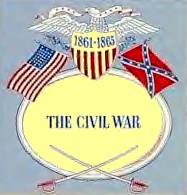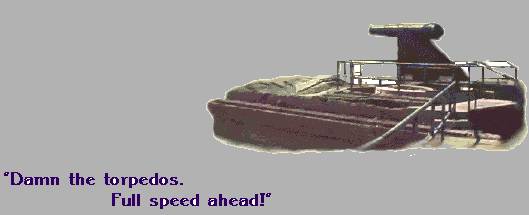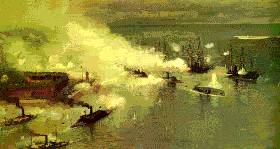|
Antietam 1st Battle of Manassas 2nd Battle of Manassas Fredericksburg |

By 1864 Mobile was one of the last Ports open to Blockade Runners bringing in supplies to the beleaguered Confederacy. In August 1864 Admiral David Farragut had assembled a large strike force of soldiers and ships to capture the Forts that guarded the entrances to Mobile Bay.
On August 3 over 1,500 troops were landed on the Western End of Dauphin Island. These troops under the command of General Gordon Granger drove the Confederate garrison on the Island back towards Fort Gaines. Skirmishing with the advancing Federals went on all day in a desperate attempt to buy time to reinforce the Fort with volunteers from Mobile. Meanwhile throughout the day the sailors aboard the fourteen wooden hulled frigates of Admiral Farragut's fleet prepared to run the gauntlet. The maneuver would be daring. Four ironclad monitors would lead the assault on Mobile Bay as a screen beside the Frigates sailing past, lashed together in pairs.
But to run between the guns of the two Forts, Gaines and Morgan, guarding the mouth of the bay would demand a heavy price. The Confederate cannoneers were busy with their own preparations for battle.
At Fort Gaines, Colonel Charles Anderson and his garrison, now inflated to over 800 men, were ordered to hold at any cost and continued to battle the Union Army.
Dawn of August 5th saw the fleet drawn up in battle line and a line of besieging Federals entrenched to the West of Fort Gaines. Anderson watched as Farragut's fleet closed in at 6:30 a.m. Suddenly, in hellish sheets of flame, the smooth bore howitzer and columbiads lashed out from Morgan's walls. Stiff geysers of water shot up around the advancing fleet. The battle of Mobile Bay was on.
As his frigates ran the passage, Farragut's boats released volleys into the Fort defenders. But the Confederate fire was more gruesome. Cannonballs heated to red hot temperatures in Fort furnaces tore into the ships hulls. "Shot after shot crushed into the Hartford" said one witness later, "mowing down men, deluging the decks with blood and scattering mangled fragments of humanity so thickly that it was difficult to stand on the deck."
Amid the carnage, a muffled roar near Morgan caught the Admirals ear. Turning with the hope of seeing a magazine within the Fort going up, he observed instead the lead bottom and screw propeller of the U.S.S. Tecumseh turning in the air. The torpedo (known today as mines) field had claimed a victim.
Startled by the event, the Fleet faltered. Sensing confusion, Morgan's gunners loaded their cannon with grapeshot to rake the decks with rapid blasts of clustered fist-sized missiles.
Farragut reacted boldly. "Damn the torpedos. Full speed ahead," he thundered down to the pilot. The Hartford lashed to the Metacomet churned into the Bay.
The pairs of Union ships steamed through the heat of Morgan's withering fire to a safe harbor out of range. The Confederate Ironclad Tennessee, commanded by Admiral Franklin Buchanan, the pre-war superintendent of Annapolis, lumbered out from Morgan's lee to engage the fleet. Three smaller defending gunboats, Sema, Gaines and Morgan, followed with a brief bombardment, but were soon disabled by the frigate's superior fire of rifled cannon.
The Tennessee was left to fight one of the most lopsided contests of naval history. Buchanan steered his unwieldy vessel with its 2" thick iron hide directly into the fleet. At once the ships converged upon the Tennessee with point blank fusillades and ramming. The courageous Confederate sailors engaged as many as seven ships at once, firing into them from as close as three feet away. Soon the Tennessee steering chains were shot away and her stack so riddled with shot that the interior of the vessel filled with smoke. Buchanan, wounded and his leg fractured, cruised his vessel to a point a mile north of Gaines' guns, where at 10:00 a.m. he surrendered.
The Admiral's attention turned immediately upon Fort Gaines and the smaller sand bank fortification, Fort Powell, at Grant's Pass. After an intense bombardment, Fort Powell was evacuated and blown up at night by its defenders. Anderson now knew it would be his fight alone.
From August 6-8, the fight for Fort Gaines raged on. The garrison was under siege from both land and sea, day and night. Nearly 3,000 Federal infantry now lay in the entrenchments to the west of the Fort and shelled the fort with their cannon. The monitors closed to nearly point blank range of the Fort and shelled the Fort with their huge 100pdr. cannons. The Fort's elderly 32pdr. cannon shells merely bounced of the monitors' tough armor.
Stubbornly the garrisons returned fire and took cover as best they could in the crowded Fort. While many of the garrison had seen action at the Battle of Shiloh, others such as the boys of the Pelham cadets (some as young as 13-15 years old) were seeing their first battle. By the 6th of August, all but one of the Fort's heavy guns were destroyed.
On August 7, a small boat bearing a flag of truce was lowered from the Hartford and rowed to the Fort with a demand for surrender. The Confederates sensing the hopelessness of any victory, visited Farragut on board his ship at the Admiral's invitation, where the Admiral served them wine. After discussion of the placement of forces against them, Anderson decided not to risk what would surely be a suicidal defense. The next day the Fort surrendered.
" I remember when this site started out as a three page Gettysburg site. Man has it grown! Great Job quot;Joe Willis--Scottsdale,AZ "This is a website for the ages!!"Bob Bullerton--Willows,CA. "I just sit here at my computer,chew on some hardtack and enjoy this site."Tico Carfello--Bronx, NY
Copyright © 2001-2005,Gettysburg Battlefield Online
|





